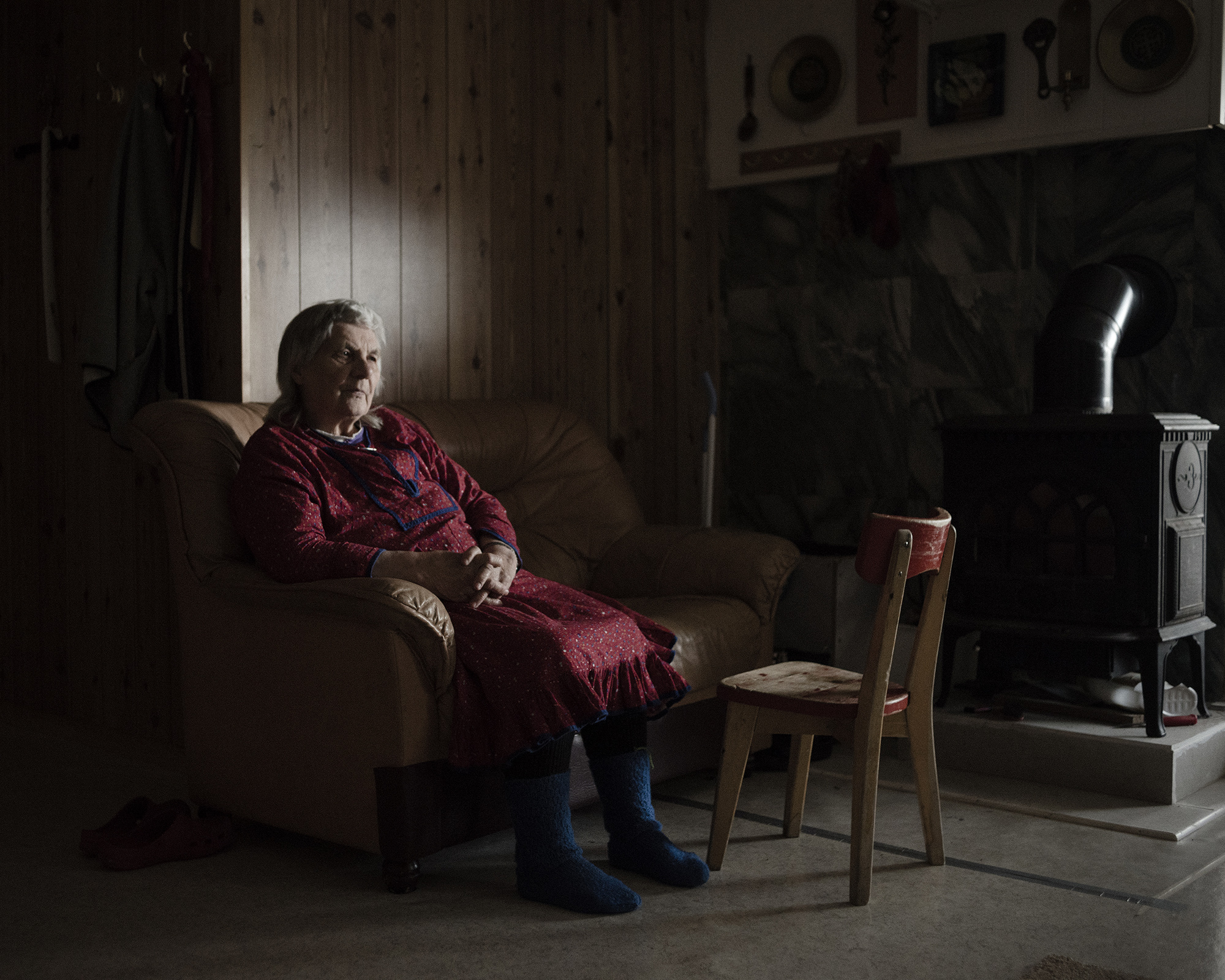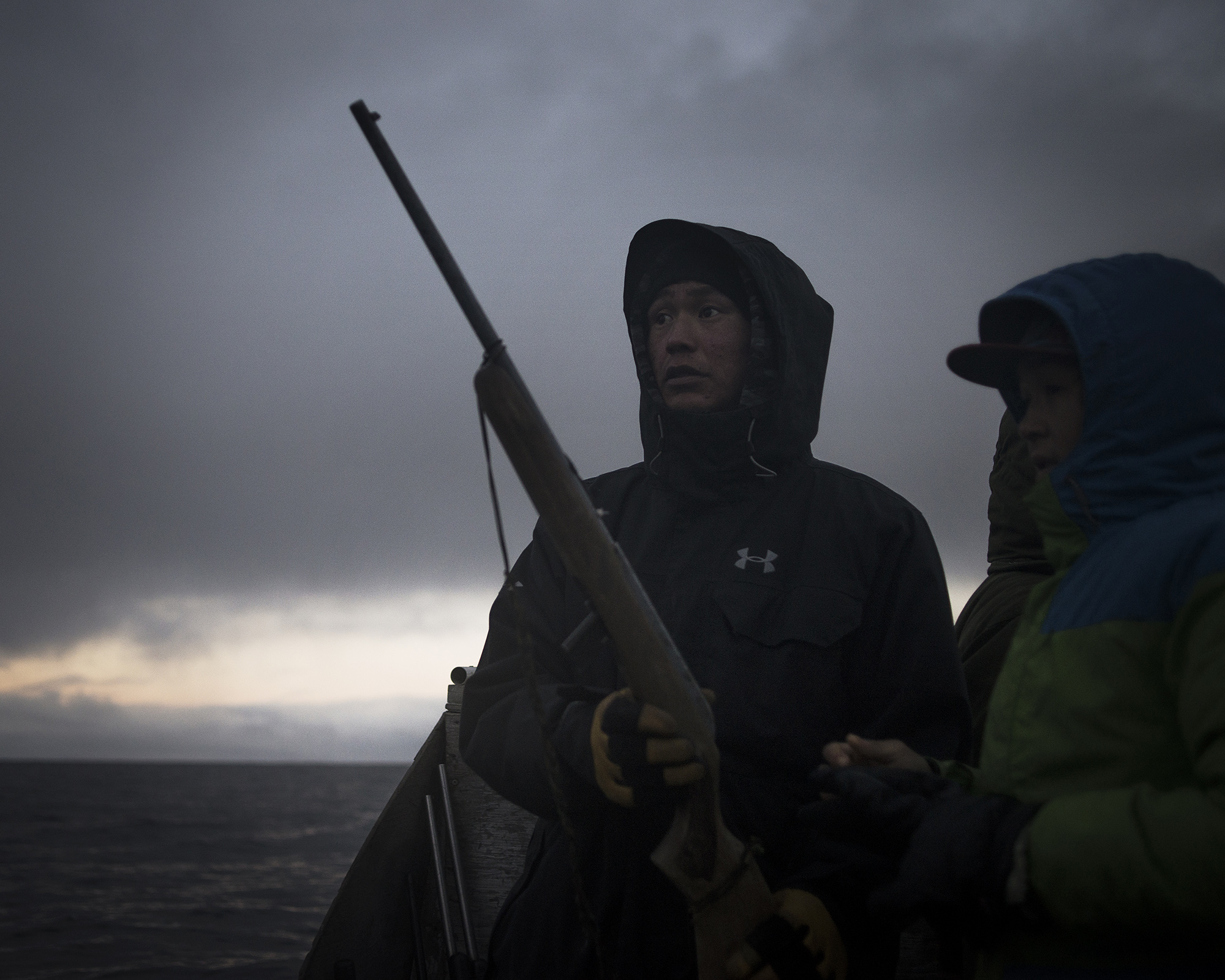Anguish in the Arctic:
Introduction
Nowhere are the effects of climate change more palpable than they are in the Arctic, where temperatures are warming at unprecedented rates, threatening traditional food sources and altering forever the way of life for the indigenous populations that call the north their home. For many, including the Sami and Inuit, the change proves too much – and the repercussions are manifesting in record rates of suicide and worsening substance abuse. As part of our series, Living Proof: The Human Toll of Climate Change, our fellows report on the sights and sounds of northern Norway, Sweden and Canada and the stories of people enduring in the Arctic.
Anguish in the Arctic:
As reindeer suffer, so do Arctic Scandinavia's indigenous Sami
LOWER SOPPERO, Sweden — Hundreds of reindeer gallop around the corral, their hooves and knees popping with the sound of a fire crackling. It’s late, but here in the land of the midnight sun, the sky is silvery and bright. A mist rolls over the Arctic tundra, framing the herders and their animals in ghostly silhouettes.
This is a community wrapped tight in tradition: The indigenous peoples of northern Scandinavia — the Sami — have herded reindeer for generations. But it is also a community in crisis. Climate change has put enormous strain on these powerful animals — and on the men and women who care for them.
With that strain has come a mental health crisis. A crisis of suicide.
The Marainen family knows it too well.

Framed photos of Gustu and Heaika Marainen sit on their parents’ kitchen counter, flanked by candles and tiny silver reindeer figurines. The brothers committed suicide within months of one another in 2014.
“That year, time stood still,” Randi Marainen, their mother, says through a translator. “Just grief.”
Sweden had one of the highest suicide rates in the world during the 20th century, but that number steadily declined over the decades, thanks to better treatment options and less stigma around mental health. Among the Sami, however, suicide is a growing problem.
About 80,000 Sami live in northern Norway, Sweden, Finland, and parts of Russia, including 20,000 in Sweden. That’s a tiny fraction of the national population of 9.85 million Swedes.
Half of Sami adults in Sweden suffer from anxiety and depression, says Petter Stoor, a Sami psychologist and researcher. According to his research, 1 in 3 young indigenous reindeer herders has seriously contemplated or attempted suicide. That’s more than double the rate among their Swedish peers. Other researchers have found rates of suicidal ideation to be nearly four times higher among Sami than among other Swedes.
For many Sami, suicide offers an escape on their terms from the inexorable force of climate change, which is eroding the traditional way of life in the Arctic.
“We are the nature people,” says Frøydis Nystad Nilsen, a Sami psychologist. “When you lose your land, you lose your identity.”
“It’s very important for us to protect nature,” she adds. “But it’s not easy.”
While nature is a major stressor in Sami life, nature may also be the cure.
Nilsen is the head doctor at an organization called SANKS (Sami Norwegian National Advisory Board on Mental Health and Substance Abuse), run by the Norwegian government. The counselors at SANKS integrate the Sami reverence for the environment and tradition into mental health treatment that addresses concerns about global warming head-on. They even offer a therapeutic camping program for families, allowing them to talk and heal over campfires, during fishing trips, on horseback rides, and while creating traditional handicrafts.
The only problem? Patients have to travel all the way to Norway to be seen. No similar programs exist in Sweden. And that can be a huge barrier to Sami in distress.
One icy January morning, Gustu was preparing to go to the mountains to check on his reindeer herd. Before he left, he paused for a moment.
“Mom, I love you,” he said.

They were the last words he would say to his mother. Three days later, after an extensive search, his body was found on the mountain. Gustu had taken his own life, guarded by his dog and surrounded by the reindeer he’d loved so much. He was 29.
The reasons, as with every case of suicide, were very complicated. But his family says he had grown more and more stressed about the fate of reindeer herding in a changing environment.
That final morning, when they were talking over breakfast at the kitchen table, Gustu told his parents that he didn’t see a bright future.
Reindeer herders in the Arctic live at ground zero of climate change. Storms, like the one that killed a herd of 300 reindeer in Norway in August, are growing in intensity and frequency. Predators are becoming more aggressive, and disease-carrying insects like ticks are moving farther north.
But perhaps the biggest threats have to do with unpredictable temperatures and extreme weather. During winter, unexpected sunny days can melt snow, followed by cold snaps that freeze the slush in layers of ice that are nearly impossible to penetrate. The reindeer exhaust themselves digging through meters of snow and ice layers to reach lichen, their primary food source. Many don’t make it through winter.
“It used to be much more stable; the winters were cold and the summers were warm,” Randi says. “Now you can have rain in the middle of the winter, and it can even start snowing in August.”
Ice bridges that link grazing lands across rivers form later in the year — and when they do finally appear, often they are unstable and collapse beneath the hooves of migrating reindeer. Spring sometimes arrives much earlier or much later, obscuring food and delaying migration.
“All of this affects the reindeer, and Gustu didn’t see a solution for this. He knew it was tough and heavy work, but it was working with reindeer that was closest to his heart,” Randi says.
The Marainen family and the Sami community reeled after Gustu took his own life. And their pain didn’t stop there.
The autumn after Gustu’s death, 21-year-old Heaika began a new job working with tourists interested in reindeer herding. Randi says he seemed happy — but Heaika had a history of depression and anxiety.
“He saw a lot, and he felt a lot, and he couldn’t take it,” Randi says.
The one activity Heaika could always rely on to cheer himself up, fishing, had more or less disappeared as well. Rising temperatures in the river winding past the Marainen home allowed bacteria to multiply, Heaika said, and fish began succumbing to disease and death.
“It’s just not fun anymore,” Heaika told his parents. With no way to relax, and with thoughts of his older brother’s death replaying in his mind, Heaika’s depression and anxiety grew dramatically worse. He told friends that he felt his brother beckoning him from the other side.

Heaika joined Gustu in November. He was 21 years old.
“It was like a bad rerun,” Randi says, wiping away tears. “We couldn’t understand that Heaika was gone as well.”
Randi wishes her sons could have sought treatment when they first became depressed — therapy that would have taken into account all of the pressures facing them as reindeer herders. They could perhaps have gone to the SANKS center in Norway. Health care is covered by the government, so treatment would have been free.
But getting there would have required taking weeks off work to travel for hours over lonely Arctic roads — simply not an option for many herders, she says. The center has treated just a handful of patients from outside Norway in the past few years.
“There’s absolutely a need for a Sami [psychology] center in Sweden,” Randi says. “The need is very big.”
In addition to family counseling, SANKS offers individual therapy and substance abuse care. Counselors are trained in disciplines from cognitive behavioral therapy to trauma therapy to psychiatry. And nearly all specialize in the Sami language.
“It is much easier to talk about hard problems in your own language,” says Nilsen, the head doctor at SANKS. She’s Sami herself and grew up speaking the language. The therapy she offers has a comforting familiarity; reindeer herders aren’t seen as exotic or treated as different. “I didn’t need to learn about Sami culture,” she says. “I am part of it.”
Programs like SANKS have helped drive down the suicide rate among Sami living in Norway in recent decades. Among adolescents, there’s no difference in the rate of suicide attempts among Sami and their non-Sami peers.
Yet opening a similar organization in Sweden would bring its own complications. For instance, Swedish law forbids doctors from asking about a patient’s ethnicity, and some argue that providing care customized to an indigenous population would also violate that rule.
The Marainens received no counseling after Gustu died, but after Heaika passed, they sought it out. The counselor was Swedish, though, and Randi and Thomas felt the impossible burden of explaining Sami life.
“I can’t explain all of my life story for them to understand,” Randi says.
Although suicide is widespread among the Sami community, mental health is still a taboo topic. Some of the Marainens’ old friends have kept a distance; sometimes they meet on the streets of Kiruna and just walk by. Maybe they are ashamed to know a family touched by suicide, Randi thinks. Maybe they don’t know what to say.
“But we are the same people we were,” she says.

Randi urges other families to talk about depression and anxiety before it’s too late. “I don’t want this to happen to anyone,” she says. “It’s not supposed to be like this.”
Randi and Thomas still struggle with grief over their sons’ deaths. But they say they have made their choice: to live.
“We have a heavy burden of sorrow, but we see a spot of light,” Randi says. She nods toward her grandchildren, playing on the kitchen floor. “I see life and hope in the small ones.”
However, the ripple effect of suicide still worries them.
“Sometimes, I still wonder: Who will be the third?” Randi says.
She and Thomas gaze out the kitchen window at the glossy river stretching by their house, cutting through summer-lush meadows under troubled skies. Along its banks, Simon Issat — their only living son — works in the yard.

Simon Issat Marainen, 36, is quiet and thoughtful. He doesn’t talk much as he works in the yard between his parents’ house and the home he shares with his partner, Beatrice, and their young daughter. But later, when Simon and his family drive out to the tundra to tend the herd, he begins to open up. Being around the herd is like being with Gustu again.
“I think that I have never been closer to him,” he says. “He’s always in my thoughts. Everything I do in the forest, everything I do on the mountain, it’s like my brother is with me.”
“They are special to me,” Simon says, watching his herd. “It’s a part of my brother.”
The reindeer are nervous this overcast evening. Their snorts and barks mingle with shouts from the herders scattered throughout the pen, standing ready with lassos to capture and mark the calves born in the spring. There aren’t as many calves as there should be.
“It’s not a good calf year,” Simon says. “When it’s deep snow, it’s very hard for the reindeer to smell where the food is.”
Many in the herd neared starvation last winter. When that happens, Simon explains, pregnant reindeer often miscarry. It’s how they conserve energy and survive. But it means fewer calves joined the herd in spring to replace reindeer sold for meat — the backbone of the herding economy.
To live as a reindeer herder is to experience constant uncertainties and stresses like these. They begin to take a toll. The herd was Gustu’s pride and joy, but also the source of his greatest trouble. In early 2014, he was struggling under the added weight of a bad business investment.
“I tried to help him in every way I could,” Simon says. He told his brother he’d be happy to lend him money. But Gustu demurred, saying, “You don’t have to take my problems on your shoulders. I don’t want that.”

“I think it’s a part of the Sami culture,” Simon says, his eyes still carefully fixed on the animals around him. “You have to be hard, you have to be strong, and you have to stand on your own feet. You don’t want too much help.”
Gustu is the one who taught him to herd. Now, Simon has full responsibility for Gustu’s animals.
“I am still helping my brother and he needs me, even if he isn’t here,” Simon says, speaking of his brother in the present tense.
Simon finds strength in nature and tradition, in reconnecting with the way his ancestors lived for thousands of years.
“When one generation stops with reindeer husbandry, it will stop forever,” he says. “Without it, we would be just like any other Swede.”
Later, at home, Simon walks out to the edge of the property and calls for his dog, a sharp ululation against the night air. The dog used to belong to Gustu; he stood guard over his master’s lifeless body for three days on the mountain, and he cried for months the winter Gustu left. Now, he’s part of Simon’s family.
The night sky has shifted into a muted blue. Once again, a fog moves in over the land.
Wisps of mist clinging to their forms, the pair turns back, toward the light and warmth of home.
The National Suicide Prevention Lifeline, a free service, is available 24/7 at 1-800-273-TALK (8255).
 A version of this story also appeared on STAT News on December 9, 2016
A version of this story also appeared on STAT News on December 9, 2016Anguish in the Arctic:
Addressing an Inuit youth suicide crisis by embracing traditions
The following is an excerpt from GroundTruth Fellow Melody Schreiber’s story published in partnership with Pacific Standard. Read the full piece here.
Mike Papoosie, 14, often doesn’t know what to do once the library closes at night. He doesn’t want to go home just to stare at the wall in his tiny bedroom, he says, because it will make him crazy.
Instead, Mike (whose name was changed for this story, in order to protect the health privacy of a minor) and his friends wander the icy roads of Clyde River, Canada, migrating like a pod of narwhal. In Clyde, this is one of the most popular activities for teens. They trudge along the snow-packed gravel, joking and talking and scanning the sky for northern lights. If they reach the end of the road, where snowy tundra takes over, they turn around. There is no destination in mind, anyway. They just try to stay moving, to keep some momentum in their lives. A new kind of nomadism.
“This town,” Mike says. “It drives some people insane.”
High above the Canadian treeline, deep within the Arctic Circle, there is a town called Clyde River. The small settlement, a scattering of one-story homes built on stilts, perches on a rising hillside over an inlet by the same name. A steady wind soars off the Arctic Ocean and sweeps across the snowy tundra, enveloping the town from every direction. In winter, temperatures regularly dip to -25 degrees Fahrenheit; in summer, they rarely reach heights of 50 degrees.
Home to about 1,000 people, Clyde River is one of the most isolated places in the world. A single road links the town’s houses, but it ends abruptly when it meets the tundra. The nearest neighboring town is hundreds of miles away—about the same distance as the shores of Greenland across the Arctic Ocean. The only way to reach Clyde—or to leave—is by a three-hour flight to Iqaluit, the capital of the Canadian territory Nunavut; or a weeks-long trip on the sealift barge that arrives once a year.

Clyde River can be a very lonely place.
For thousands of years, nomadic Inuit ranged across the land and sea, hunting seals, polar bears, narwhal, and the occasional bowhead whale, and fishing for arctic char and salmon. They were experts in self-sufficiency—thriving, for millennia, in the harshest conditions known to man. Back then, the isolation of the Arctic didn’t mean loneliness. It meant freedom.
But now, the Inuit of Clyde River and other communities in Nunavut face unprecedented challenges. With polar sea ice descending to record lows and wintertime temperatures ascending to astonishing heights, climate change directly affects their traditional way of life.
Change is nothing new here. In the last six decades, the Inuit have seen a rapid and unprecedented transformations in their way of life. Within a single generation, they endured an erosion of their land rights and forced relocation to permanent settlements; their dog teams were slaughtered and their children were taken to far-off residential schools where abuse ran rampant. These rapid social changes introduced a slew of associated problems: drug and alcohol addiction, child abuse, food insecurity, depression and anxiety.
Now, however, all of these traumas are being compounded, as the very landscape upon which the Inuit survive changes in dramatic ways.
“The Canadian Arctic is widely regarded as a global hotspot of the effects of current and future climate change,” researchers reported in 2014 in the American Journal of Public Health. The debate, others say, is no longer over whether climate change exists; the conversation has quickly shifted to what to do about it, now that communities have already begun experiencing changes.
In the Arctic, annual sea ice began forming later and sometimes not at all; then multi-year ice began melting in the middle of winter. The surfaces upon which hunters travel have become more treacherous and difficult to assess; often the ice looks solid from above, but has melted from below. Unpredictable and severe storms crop up suddenly while hunters are out on the land, leaving even the most experienced hunters stranded for days—and some don’t make it.
Even the animals themselves have changed, with new behavior and migration patterns. To protect vulnerable species, the wildlife office of Canada’s Department of the Environment monitors animal populations and enforces strict quotas. Hunters may only kill and eat a handful of polar bears and whales each year; the caribou hunt is even more limited.
Such insecurity in the face of a melting world affects every part of life, from finding enough food to holding on to traditions. But it goes deeper than shifts in the landscape: Climate change has a profound effect upon mental health.
Nunavut is ground zero for climate change, but it may also be ground zero for suicide. Nunavut has one of the highest rates of suicide in the world: 10 times the rest of Canada, and similar to that of Greenland, which has been dubbed the suicide capital of the world. Experts have called it a public health emergency, and in October 2015, Nunavut’s premier declared youth suicide a crisis. Among teen boys—young men who have seen their futures melt away like glaciers—the suicide rate soars up to 40 times their Canadian peers.
This is an excerpt from a larger story published in Pacific Standard.
 A version of this story appeared on PACIFIC STANDARD on March 23, 2018
A version of this story appeared on PACIFIC STANDARD on March 23, 2018Anguish in the Arctic:
Hunting for Hope with the Clyde River Inuit
The Clyde River Inuit, like the Sami of Scandinavia, were forcibly assimilated, and are grappling with the consequences of those programs. The task of trying to recover their traditions is made even more difficult by climate change. The Inuit are hunters, and climate change in the Arctic has made hunting extremely difficult. As Camilla Andersen writes, the modern tools for hunting are unaffordable for most Inuit. And when they do go hunting, they are likely to come home empty handed and with an empty gas tank. On top of that, buying food is extremely expensive, reflecting the cost of shipping it up to remote Clyde River. Seventy percent of Clyde River residents experience food insecurity. But hope still persists, as community organizations recognize the link between cultural preservation and their community’s well being.
 A version of this photo essay appeared on TIME on July 12, 2017
A version of this photo essay appeared on TIME on July 12, 2017Anguish in the Arctic:
Hear the podcast & explore the science
Behind the Science
Sweden had one of the highest suicide rates in the world during the 20th century, but that number steadily declined over the decades. However, among Sweden’s indigenous Sami, suicide is a growing problem. Half of Sami adults in Sweden suffer from anxiety and depression, says Petter Stoor, a Sami psychologist and researcher. And according to his research, one in three indigenous reindeer herders has seriously contemplated or attempted suicide—rates more than double their peers in Sweden. In some places, that rate can jump to nearly four times their peers, other researchers have found. The reasons are complex and interlinked, but chief among them is climate change. Extreme weather is eroding the traditional way of life in the Arctic.
The Arctic is warming twice as fast as the rest of the world, and this year saw even more record-breaking highs and lows: polar sea ice fell to record lows and temperatures soared to 36 degrees Fahrenheit above average. Over the last three decades, Scandinavian winters have become two months shorter, researchers at Umeå University have found. Weather has become more severe and unstable, which causes changes in vegetation and “the freeze–thaw cycle” – and which contributes to stress and anxiety among Sami reindeer herders.
Fish are also affected by climate change. Changing ice-melt patterns can disrupt salmon migration and health, and warmer rivers may invite invasive species – including diseases and parasites like viral hemorrhagic septicemia that can decimate fish stocks.




























































